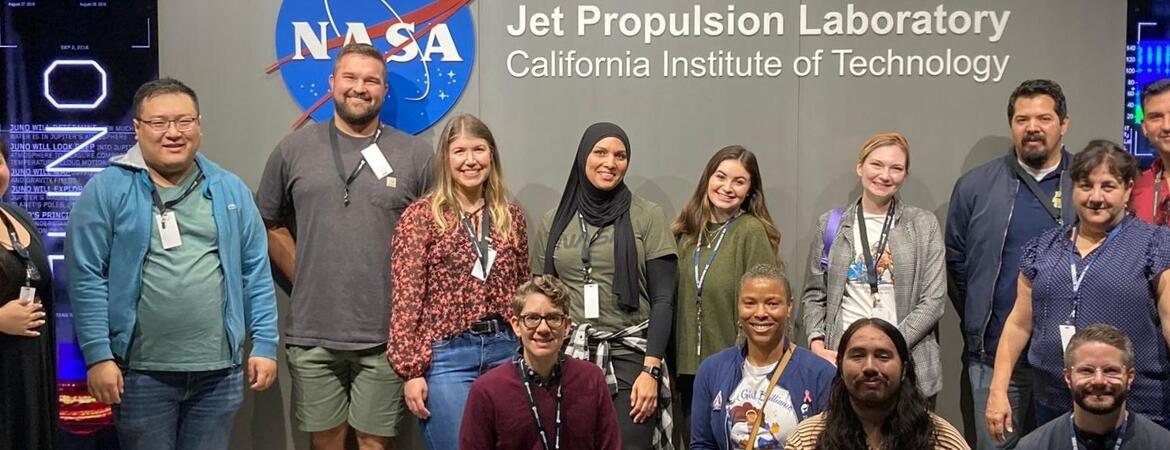
Pasadena, CA — Twelve STEM educators from eight California school districts convened this week at NASA’s Jet Propulsion Laboratory (JPL) in Pasadena for the launch of a three-day STEM Educator Institute. Organized by the University of California, Riverside (UCR) School of Education (SOE) in partnership with NASA JPL, the Institute aims to equip teachers with advanced, inclusive strategies for STEM education that can be directly implemented in their classrooms. The event, which kicked off on October 28, marks an innovative step in integrating NASA’s cutting-edge resources into K-12 education across Southern California.
The Fall 2024 STEM Educator Institute, co-hosted by Dr. Cathy Lussier, Associate Professor of Teaching at the SOE, and NASA STEM Educators Brandon Rodriguez and Lyle Tavernier, brings together a unique team of participants, many of whom are alumni of the UCR School of Education. These 12 educators, representing school districts such as Riverside Unified, Los Angeles Unified, Moreno Valley, and San Bernardino, are engaging in interactive sessions that leverage NASA’s technological resources to advance STEM learning and inspire a new generation of students.
“Seeing firsthand NASA’s research facilities, including JPL’s spacecraft assembly facility and Mars rover projects, allows teachers to experience the thrill of scientific exploration,” said Dr. Lussier, who leads research on inclusive STEM teaching and curriculum. “The goal is for educators to carry this inspiration and knowledge back to their schools, where they can foster a greater connection between students and real-world 21st-century STEM challenges.”
Transforming STEM Curriculum with NASA Resources
During Day 1 of the Institute, educators explored JPL’s unique resources and participated in activities designed to enhance problem-solving and interdisciplinary thinking—core skills essential for addressing contemporary challenges in science, technology, engineering, and mathematics (STEM) fields. The sessions encouraged teachers to rethink traditional STEM teaching and develop more innovative, inclusive lesson plans that reflect the complexity and interconnectedness of real-world problems.
One notable moment came when the team had the opportunity to tour JPL’s spacecraft assembly facility, where they observed the NEO Surveyor in production (expected launch 2027). This infrared telescope is set to search for near-by objects hazardous to Earth. Educators used this experience to brainstorm ways to bring the excitement of space exploration into their classrooms and to discuss with JPL experts how such resources can enrich student engagement and comprehension in subjects like physics, chemistry, biology, and mathematics.
“These workshops are so critical for teachers not just to provide more content experience for teachers exploring STEM instruction, but because they give teachers the chance to explore context for these subject areas,” said Brandon Rodriguez from NASA. “Seeing the hard work and hearing the stories of JPL scientists and engineers allows teachers to take real life careers and futures to our students who will be the next generation of problem solvers.”
Building a Community of STEM Education Leaders
The team of instructors participating in the Institute includes alumni from both UCR and UC Irvine, many of whom have continued to support their communities through involvement in educational outreach and research programs. This collaborative effort with NASA aims to enhance the participants’ leadership in STEM education by providing unique resources, curriculum insights, and networking opportunities.
Following the training, teachers will bring the knowledge and materials developed at JPL back to their schools, where they plan to conduct workshops and integrate new methods into their STEM courses. This ripple effect is designed to increase student access to high-quality STEM learning experiences and build a more inclusive environment for students of all backgrounds.
Continuing the Mission: Days 2 and 3
The Institute will continue over two additional training days in November, with each session building upon the themes of inclusivity, real-world problem solving, and innovative teaching strategies. Over the coming weeks, participants will engage with NASA and UCR experts on implementing interdisciplinary lessons that blend scientific knowledge with practical applications in areas such as climate science, technology design, and engineering principles.
Through this partnership, NASA JPL and UCR are working together to expand the role of STEM educators in preparing students to navigate and solve the 21st century’s most pressing challenges. As these teachers return to their classrooms, they carry with them the tools and inspiration to transform STEM education for the next generation.
For more information, visit https://education.ucr.edu